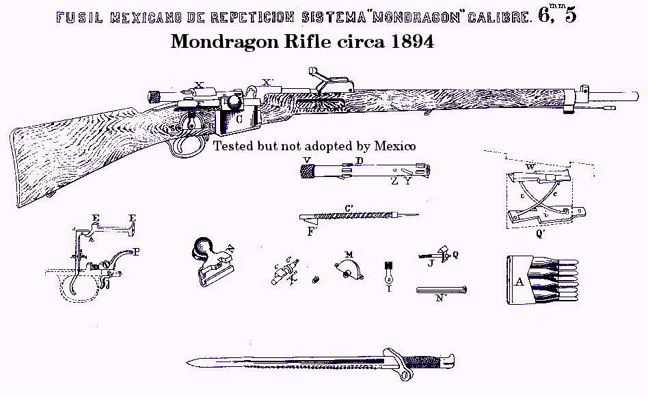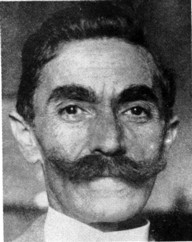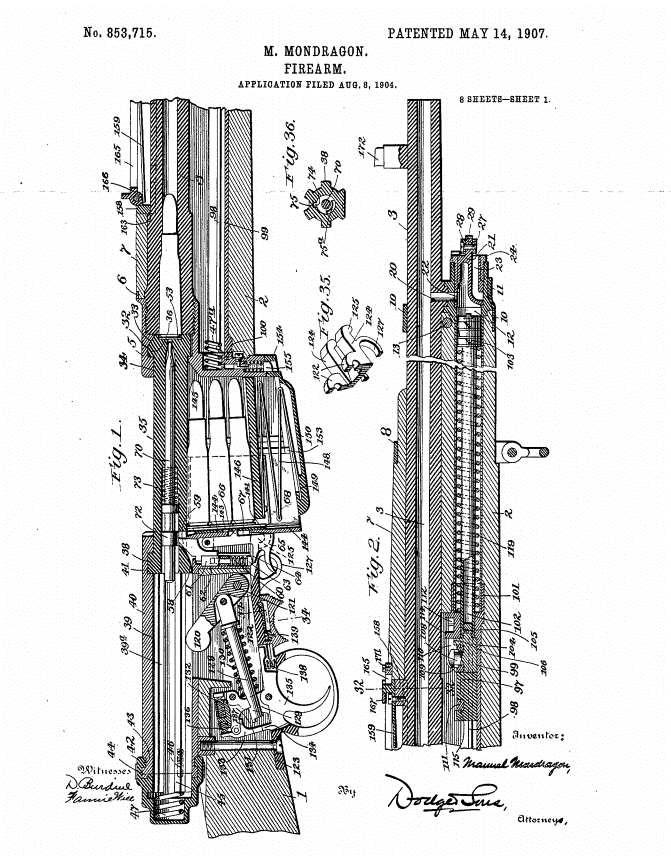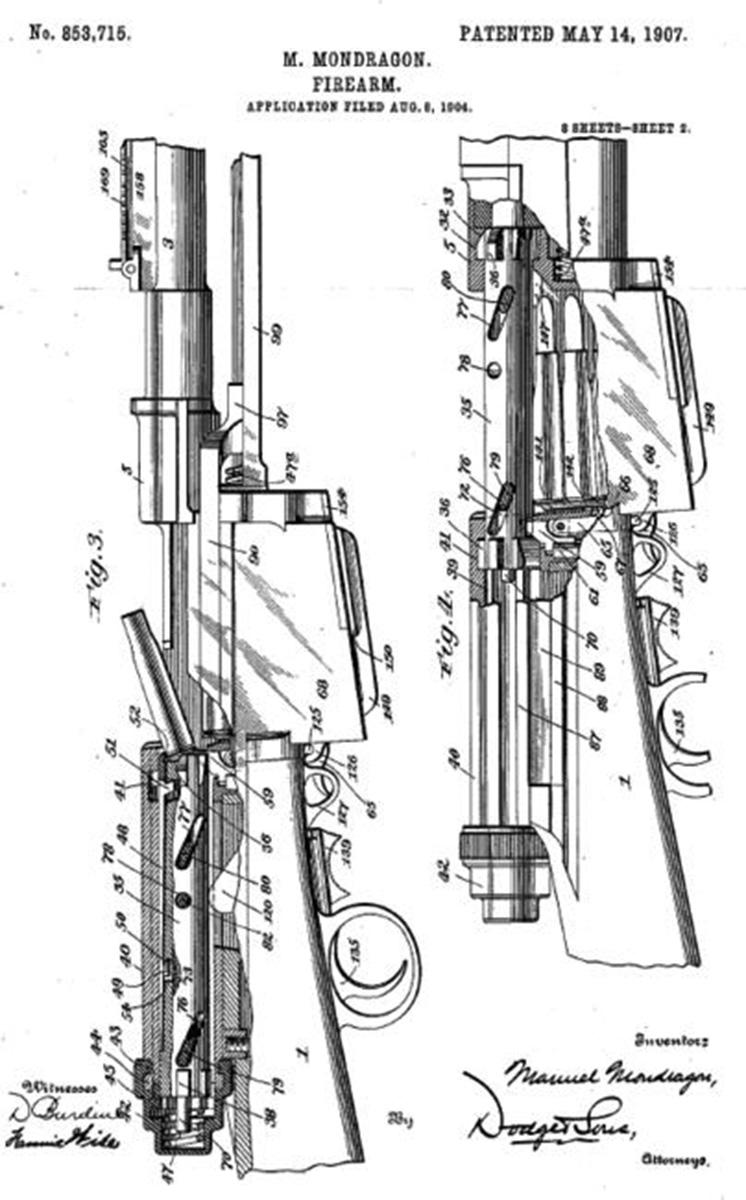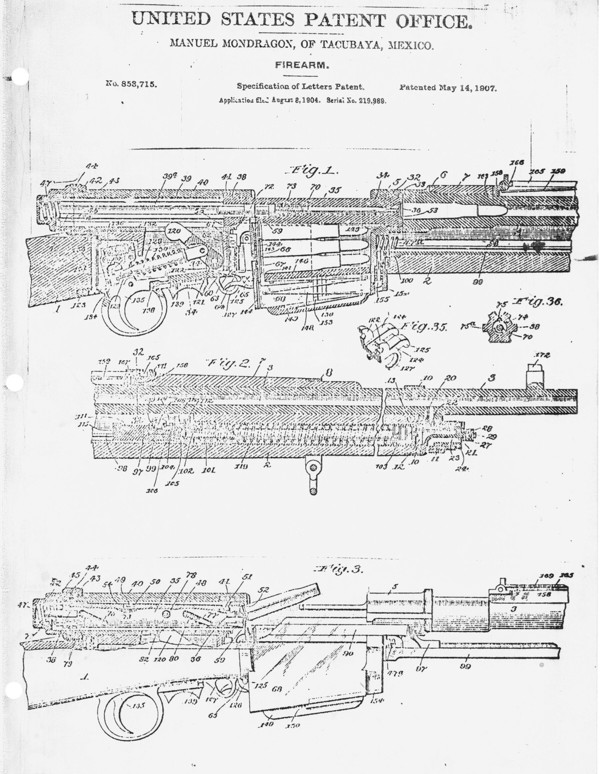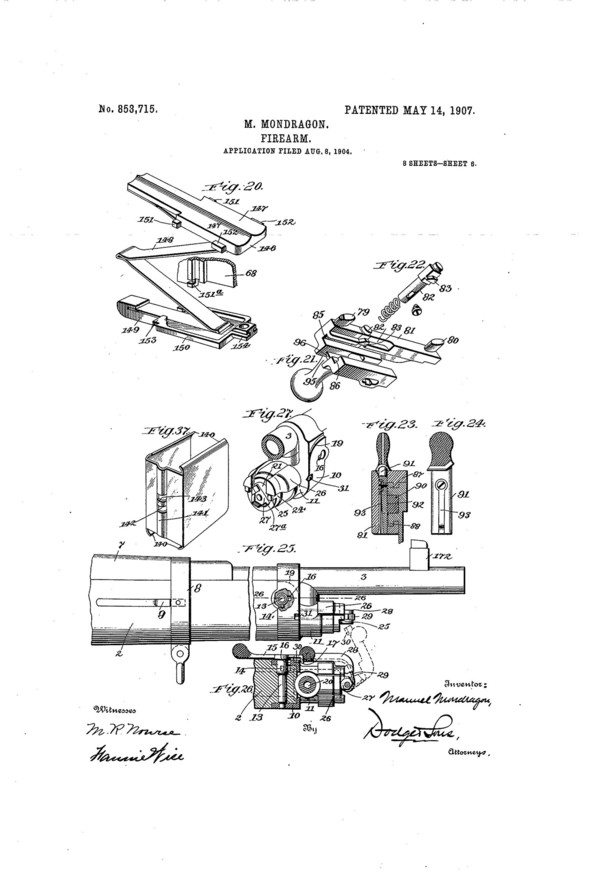

The 1907 Mondragon was one of the first semiautomatic rifles formally adopted by a national military. It was designed by Mexican Manuel Mondragon, beginning in 1891. Its development was encouraged by future Mexican President Porfirio Diaz, who was very interested in military arms and eager for the prestige of Mexico being the first nation to field a semiautomatic shoulder rifle.
DEVELOPMENT
The first Mondragon rifles were bolt actions produced in 1893, chambered for 6.5mm Mondragon. Production of the rifle was outsourced to the Swiss firm SIG in Neuhausen, which delivered 50 units for testing by the Mexican army. The trials were successful enough to warrant an order for 200 more rifles in 1894, in a theoretically better 5.2 x 68mm cartridge. This was developed by Mondragon in collaboration with the Swiss Colonel Rubin (of Schmidt-Rubin rifle notability), and was a very high pressure round. Too high pressure to work well, as it turned out. Later variants of the Mondragon returned to more conventional cartridges, with a 1903 model being submitted to British army testing chambered for 7mm Mauser. Rifles were also produced in 7.5mm Swiss and .30-30 Winchester.
The main contract for the Mexican Army was placed in 1908, for 4,000 rifles in 7mm Mauser. Some of these, in an effort to ingratiate President Diaz, were marked “Fusil Porfirio Diaz, Systema Mondragon, Model 1908. The first 400 were delivered in 1911, and it was found (as had been warned by SIG officials) that the guns had very little tolerance for poor quality ammunition. Much to SIG’s dismay, the Mexican government decided to cancel the order after only 1,000 had been delivered, leaving SIG with 3,000 finicky rifles not paid for. Once the First World War broke out, demand for military arms was predictably great, and SIG found a buyer for the Mondragon rifles in the German air corps. It was adopted as the Flieger-Selbstlader-Karabiner 15 (Self-Loading Aircraft Carbine, Model 1915) as a stopgap measure to give aerial observers a firearm that could be effectively used in flight. For this use, the guns were equipped with a 30-round snail drum type magazine. Significant maintenance was required to keep the rifles operational, and accuracy was reportedly poor. They were subsequently replaced by the more accurate but even less reliable Mauser Selbstlader 1916.
The Mondragon was not a major part of any armed conflict, but remains a landmark weapon for being the first of its kind effective enough to be used in quantity by a national military.
FUNCTION AND MECHANISM
The Mondragon is a gas-operated rifle, with a gas port about three quarters of the way down the barrel. The bolt is of the rotating type, turned by two helical camming slots on the bolt body. There are three locking lugs on the front of the bolt and four more on the rear. One unusual feature of the Mondragon is a cutoff switch on the bolt handle which allows the shooter to disengage the bolt from the gas piston. This, like the magazine cutoffs present on many early magazine rifles, was a feature desired by many military authorities to prevent soldiers from wasting ammunition through rapid fire. The notion was that the guns would be operated as manual straight-pull actions during normal use, and only switched to semiautomatic mode in emergencies.
Upon firing, gas engages the gas piston below the barrel pushing it back and compressing the mainspring. Instead of being directly connected to the bolt, the gas piston ends with a stub which acts on the bolt handle (which can be disengaged to render the gun manually operated). The bolt handle has lugs which engage the helical cams in the bolt body, so when retracted by the shooter of the gas system, it rotates and unlocks the bolt. In an effort seal gasses out of the receiver, the gas piston is fitted with a series of split rings.
The 1904/1907 version of the rifle is designed to use a 6-round enbloc clip. This clip could be latched in at two different depths in the magazine housing – pushed all the way in; the clip would below the line of bolt travel and held in reserve like a magazine cutoff. A latch behind at the back of the magazine housing would release the clip upwards to where rounds would be stripped off by the bolt, allowing semiautomatic fire. This feature was removed at some point, as the clip latch is not present on most Mondragon rifles. Some variants were made to use 20-round box magazines, in addition to the German 30-round drum. The rifle used a leaf sight marked from 300-2000 yards, and it was issued with a spade-type bayonet. (Source: http://defence.pk/)
Manual Mondragon was educated at the French Military Academy at St. Cyr, and was eventually trained in the Mexican Military. He developed several new and highly advanced weapons for the Mexican Army to include some field artillery and ultimately the development of the Model 1908 semi-automatic rifle. He chose the Swiss SIG factory because they were the only company in the world at this time was the capable of producing any weapon(s) on a mass production basis with such close tolerances as required in the Mondragon design. In 1908 this gas operated semi-automatic rifle was probably the most advanced rifle in the world at that time, in an era when most countries were just starting to transition to single shot rifles to bolt action or lever action repeating rifles. It was fielded with the Mexican Army in 1908 and was the first country to issue a semi-automatic rifle to its army. The unique aspect of this weapon was the basic design itself in that it had a “10” round internal box magazine and the rifle was a semi-automatic weapon. No other weapon in the world could make this claim at this time. At the heart of this rifles design is the gas block/gas port design which is mounted on the end of the barrel. The gas block is attached to an operating rod which is mounted in forend section of the stock, which cycles the bolt mechanism, much the same as on the FN FAL, M1 Garand and M14 rifles of today. Truly revolutionary in 1908, as if you just think about the US Army which had just switched from the 1898 Krag bolt action rifle to the 1903 Springfield Mauser design, still a bolt action rifle. It would take almost another 34 years, not until WWII that the US Military would adopt a semi-automatic rifle.
